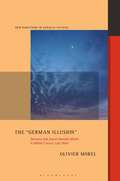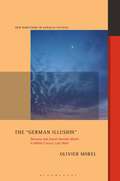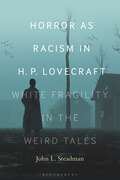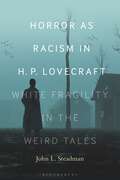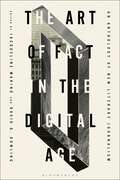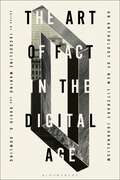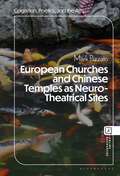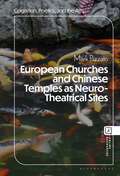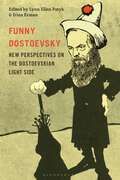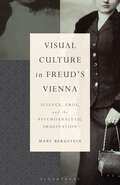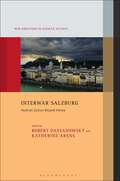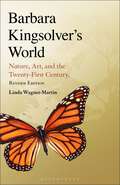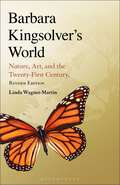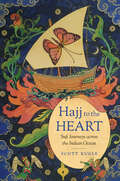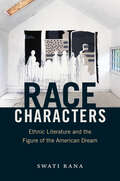- Table View
- List View
The "German Illusion": Germany and Jewish-German Motifs in Hélène Cixous’s Late Work (New Directions in German Studies)
by Professor or Dr. Olivier MorelExamines Jewish-German “tropes” in Hélène Cixous's oeuvre and life and their impact on her work as a feminist, poet, and playwright.Hélène Cixous is a poet, philosopher, and activist known worldwide for her manifesto on Écriture feminine (feminine writing) and for her influential literary texts, plays, and essays. While the themes were rarely present in her earlier writings, Germany and Jewish-German family figures and topics have significantly informed most of Cixous's late works. Born in Algeria in June 1937, she grew up with a mother who had escaped Germany after the rise of Nazism and a grandmother who fled the racial laws of the Third Reich in 1938. In her writing, Cixous refines the primitive scene of a “German” upbringing in French-occupied colonial, antisemitic Algeria.Scholar and filmmaker Olivier Morel delves into the signs and influences that “Germany,” “German,” and “Osnabrück” have exerted over Cixous's work. Featuring an exclusive interview with Hélène Cixous and stills from their travel together to Osnabrück in Morel's 2018 documentary, Ever, Rêve, Hélène Cixous, Morel's The “German Illusion” examines the unique literary meditation on the Holocaust sustained throughout her later texts. Morel helps us to understand an uncannily original oeuvre that embodies the complexities of modernity's genocidal history in a new way.
The "German Illusion": Germany and Jewish-German Motifs in Hélène Cixous’s Late Work (New Directions in German Studies)
by Professor or Dr. Olivier MorelExamines Jewish-German “tropes” in Hélène Cixous's oeuvre and life and their impact on her work as a feminist, poet, and playwright.Hélène Cixous is a poet, philosopher, and activist known worldwide for her manifesto on Écriture feminine (feminine writing) and for her influential literary texts, plays, and essays. While the themes were rarely present in her earlier writings, Germany and Jewish-German family figures and topics have significantly informed most of Cixous's late works. Born in Algeria in June 1937, she grew up with a mother who had escaped Germany after the rise of Nazism and a grandmother who fled the racial laws of the Third Reich in 1938. In her writing, Cixous refines the primitive scene of a “German” upbringing in French-occupied colonial, antisemitic Algeria.Scholar and filmmaker Olivier Morel delves into the signs and influences that “Germany,” “German,” and “Osnabrück” have exerted over Cixous's work. Featuring an exclusive interview with Hélène Cixous and stills from their travel together to Osnabrück in Morel's 2018 documentary, Ever, Rêve, Hélène Cixous, Morel's The “German Illusion” examines the unique literary meditation on the Holocaust sustained throughout her later texts. Morel helps us to understand an uncannily original oeuvre that embodies the complexities of modernity's genocidal history in a new way.
Horror as Racism in H. P. Lovecraft: White Fragility in the Weird Tales
by Dr. or Prof. John L. SteadmanProviding a new perspective on Lovecraft's life and work, Horror as Racism in H.P. Lovecraft focuses on the overlap between the writer's personal beliefs and the racist images and narratives in his speculative fiction. Building on recent debates about Lovecraft and drawing on the concept of "white fragility," John Steadman argues that the writer's fiction reflects his feelings of resentment and anger towards non-white persons and was used to advocate for his racist, xenophobic political beliefs – that western civilization was in decline and slavery was justifiable among "superior" civilizations. In making these claims, Lovecraft's tales pit humans against extra-terrestrial aliens, developing a terrifying, futuristic vision of the Earth as a plantation planet. The familiar image of Lovecraft as a reclusive, creative genius and mentor to young writer-friends is dismantled through close readings of his fiction and nonfiction – including correspondence, essays, and poetry – and examination of his early biography. This image is replaced by that of a cruel, callous, and, at times, psychotic man, a violently vitriolic racist and white supremacist who hated most of the non-white races. While some will dismiss the author outright and others will read his fiction but ignore the racism, Horror as Racism in H.P. Lovecraft takes a middle ground: acknowledging Lovecraft's personal history and heinous intentions, it helps readers navigate the author's disturbing biography while also getting a better sense of the stories, which remain significant within American science fiction.
Horror as Racism in H. P. Lovecraft: White Fragility in the Weird Tales
by Dr. or Prof. John L. SteadmanProviding a new perspective on Lovecraft's life and work, Horror as Racism in H.P. Lovecraft focuses on the overlap between the writer's personal beliefs and the racist images and narratives in his speculative fiction. Building on recent debates about Lovecraft and drawing on the concept of "white fragility," John Steadman argues that the writer's fiction reflects his feelings of resentment and anger towards non-white persons and was used to advocate for his racist, xenophobic political beliefs – that western civilization was in decline and slavery was justifiable among "superior" civilizations. In making these claims, Lovecraft's tales pit humans against extra-terrestrial aliens, developing a terrifying, futuristic vision of the Earth as a plantation planet. The familiar image of Lovecraft as a reclusive, creative genius and mentor to young writer-friends is dismantled through close readings of his fiction and nonfiction – including correspondence, essays, and poetry – and examination of his early biography. This image is replaced by that of a cruel, callous, and, at times, psychotic man, a violently vitriolic racist and white supremacist who hated most of the non-white races. While some will dismiss the author outright and others will read his fiction but ignore the racism, Horror as Racism in H.P. Lovecraft takes a middle ground: acknowledging Lovecraft's personal history and heinous intentions, it helps readers navigate the author's disturbing biography while also getting a better sense of the stories, which remain significant within American science fiction.
The Art of Fact in the Digital Age: An Anthology of New Literary Journalism
The Art of Fact in the Digital Age is a showcase of the most powerful and moving journalism of the past 25 years. Selections include stories originally published in established bastions of literary journalism (The New York Times, The Atlantic and The New Yorker), as well as those from specialized and online publications (Runner's World, The Atavist). It features writers of extraordinary style (including Carina del Valle Schorske, Brian Phillips, and Jia Tolentino), as well as those who have profoundly influenced public discourse on the 21st century's most urgent issues: Mitchell S. Jackson, Clint Smith, and Ta-Nehisi Coates on race; Susan Dominus and Luke Mogelson on migration; and Kathryn Schulz and David Wallace-Wells on environmental threats. It even includes one story that expanded literary journalism's repertoire into audio (This American Life). This collection, assembled for students, scholars, and practitioners alike, also charts the evolution of digital longform journalism through its greatest achievements, from transitioning readers to screens to the integration of multimedia with words in service of meaning. The art of fact in the 21st century opened new ranges of expression to address such issues, while uniquely bearing the imprint of their generation's digital cultures and technologies. Although many forces compete for attention in the digital age, story triumphs. The works in this anthology show us why.
The Art of Fact in the Digital Age: An Anthology of New Literary Journalism
by Jacqueline Marino and David O. DowlingThe Art of Fact in the Digital Age is a showcase of the most powerful and moving journalism of the past 25 years. Selections include stories originally published in established bastions of literary journalism (The New York Times, The Atlantic and The New Yorker), as well as those from specialized and online publications (Runner's World, The Atavist). It features writers of extraordinary style (including Carina del Valle Schorske, Brian Phillips, and Jia Tolentino), as well as those who have profoundly influenced public discourse on the 21st century's most urgent issues: Mitchell S. Jackson, Clint Smith, and Ta-Nehisi Coates on race; Susan Dominus and Luke Mogelson on migration; and Kathryn Schulz and David Wallace-Wells on environmental threats. It even includes one story that expanded literary journalism's repertoire into audio (This American Life). This collection, assembled for students, scholars, and practitioners alike, also charts the evolution of digital longform journalism through its greatest achievements, from transitioning readers to screens to the integration of multimedia with words in service of meaning. The art of fact in the 21st century opened new ranges of expression to address such issues, while uniquely bearing the imprint of their generation's digital cultures and technologies. Although many forces compete for attention in the digital age, story triumphs. The works in this anthology show us why.
European Churches and Chinese Temples as Neuro-Theatrical Sites (Cognition, Poetics, and the Arts)
by Prof. or Dr. Mark PizzatoCompares monumental designs and performance spaces of Christian, Buddhist, and related sanctuaries, exploring how brain networks, animal-human emotions, and cultural ideals are reflected historically and affected today as "inner theatre" elements. Integrating research across the humanities and sciences, this book explores how traditional designs of outer theatrical spaces left cultural imprints for the inner staging of Self and Other consciousness, which each of us performs daily based on how we think others view us. But believers also perform in a cosmic theatre. Ancestral spirits and gods (or God) watch and interact with them in awe-inspiring spaces, grooming affects toward in-group identification and sacrifice, or out-group rivalry and scapegoating. In a study of over 80 buildings – shown by 40 images in the book, plus thousands of photos and videos online – Pizzato demonstrates how they reflect meta-theatrical projections from prior generations. They also affect the embodied, embedded, enacted, and extended (4E) cognition of current visitors, who bring performance frameworks of belief, hope, and doubt to the sacred site. This involves neuro-social, inner/outer theatre networks with patriarchal, maternal, and trickster paradigms. European Churches and Chinese Temples as Neuro-Theatrical Sites investigates performative material cultures, creating dialogs between theatre, philosophy, history, and various (cognitive, affective, social, biological) sciences. It applies them to the architecture of religious buildings: from Catholic, Orthodox, and Protestant in Europe, plus key sites in Jerusalem and prior “pagan” temples, to Buddhist, Daoist, Confucian, and imperial in China. It thus reveals individualist/collectivist, focal/holistic, analytical/dialectical, and melodramatic/tragicomic trajectories, with cathartic poetics for the future.
European Churches and Chinese Temples as Neuro-Theatrical Sites (Cognition, Poetics, and the Arts)
by Prof. or Dr. Mark PizzatoCompares monumental designs and performance spaces of Christian, Buddhist, and related sanctuaries, exploring how brain networks, animal-human emotions, and cultural ideals are reflected historically and affected today as "inner theatre" elements. Integrating research across the humanities and sciences, this book explores how traditional designs of outer theatrical spaces left cultural imprints for the inner staging of Self and Other consciousness, which each of us performs daily based on how we think others view us. But believers also perform in a cosmic theatre. Ancestral spirits and gods (or God) watch and interact with them in awe-inspiring spaces, grooming affects toward in-group identification and sacrifice, or out-group rivalry and scapegoating. In a study of over 80 buildings – shown by 40 images in the book, plus thousands of photos and videos online – Pizzato demonstrates how they reflect meta-theatrical projections from prior generations. They also affect the embodied, embedded, enacted, and extended (4E) cognition of current visitors, who bring performance frameworks of belief, hope, and doubt to the sacred site. This involves neuro-social, inner/outer theatre networks with patriarchal, maternal, and trickster paradigms. European Churches and Chinese Temples as Neuro-Theatrical Sites investigates performative material cultures, creating dialogs between theatre, philosophy, history, and various (cognitive, affective, social, biological) sciences. It applies them to the architecture of religious buildings: from Catholic, Orthodox, and Protestant in Europe, plus key sites in Jerusalem and prior “pagan” temples, to Buddhist, Daoist, Confucian, and imperial in China. It thus reveals individualist/collectivist, focal/holistic, analytical/dialectical, and melodramatic/tragicomic trajectories, with cathartic poetics for the future.
Funny Dostoevsky: New Perspectives on the Dostoevskian Light Side
by Lynn Ellen Patyk and Irina ErmanTapping into the emergence of scholarly comedy studies since the 2000s, this collection brings new perspectives to bear on the Dostoevskian light side. Funny Dostoevksy demonstrates how and why Dostoevsky is one of the most humorous 19th-century authors, even as he plumbs the depths of the human psyche and the darkest facets of European modernity. The authors go beyond the more traditional categories of humor, such as satire, parody, and the carnivalesque, to apply unique lenses to their readings of Dostoevsky. These include cinematic slapstick and the body in Crime and Punishment, the affective turn and hilarious (and deadly) impatience in Demons, and ontological jokes in Notes from Underground and The Idiot. The authors – (coincidentally?) all women, including some of the most established scholars in the field alongside up-and-comers – address gender and the marginalization of comedy, culminating in a chapter on Dostoevsky's "funny and furious" women, and explore the intersections of gender and humor in literary and culture studies. Funny Dostoevksy applies some of the latest findings on humor and laughter to his writing, while comparative chapters bring Dostoevsky's humor into conjunction with other popular works, such as Chaplin's Modern Times and Lin-Manuel Miranda's Hamilton. Written with a verve and wit that Dostoevsky would appreciate, this boldly original volume illuminates how humor and comedy in his works operate as vehicles of deconstruction, pleasure, play, and transcendence.
Funny Dostoevsky: New Perspectives on the Dostoevskian Light Side
Tapping into the emergence of scholarly comedy studies since the 2000s, this collection brings new perspectives to bear on the Dostoevskian light side. Funny Dostoevksy demonstrates how and why Dostoevsky is one of the most humorous 19th-century authors, even as he plumbs the depths of the human psyche and the darkest facets of European modernity. The authors go beyond the more traditional categories of humor, such as satire, parody, and the carnivalesque, to apply unique lenses to their readings of Dostoevsky. These include cinematic slapstick and the body in Crime and Punishment, the affective turn and hilarious (and deadly) impatience in Demons, and ontological jokes in Notes from Underground and The Idiot. The authors – (coincidentally?) all women, including some of the most established scholars in the field alongside up-and-comers – address gender and the marginalization of comedy, culminating in a chapter on Dostoevsky's "funny and furious" women, and explore the intersections of gender and humor in literary and culture studies. Funny Dostoevksy applies some of the latest findings on humor and laughter to his writing, while comparative chapters bring Dostoevsky's humor into conjunction with other popular works, such as Chaplin's Modern Times and Lin-Manuel Miranda's Hamilton. Written with a verve and wit that Dostoevsky would appreciate, this boldly original volume illuminates how humor and comedy in his works operate as vehicles of deconstruction, pleasure, play, and transcendence.
Thought as Experience in Bataille, Cioran, and Rosset
by Professor Joseph AcquistoExamines how postwar French writers constitute the thinking subject and reshape its relation to the external social world.Joseph Acquisto analyzes the writings of three thinkers during and shortly after the Second World War who address the question of what it means to think, and what it means to constitute oneself as a thinking subject – at a time that seems to come "after everything"; with the ruins of attacked cities echoing the remains of a philosophical tradition that was confident in its establishment of human beings as rational, of reason leading to progress, and of both the self and the world as knowable. What Georges Bataille calls "inner experience" and Emil Cioran labels "thinking against oneself" is something akin to a drama; not a mere representation of the self in relation to the world, but a process of remapping the relation of subject to object of thought dialectically. Acquisto argues that both writers adopt an anti-systematic approach to thinking that implicates fragmentary writing as a way of turning answers about subject-object relations into questions. Acquisto contends that this stands in contrast to the approach of Clément Rosset, whose affirmation of the inaccessibility of the real leads to an anti-intellectual, grace-filled affirmation of life as it is given, under the guise of what he calls the "tragic."Bringing together thinkers that have seldom been discussed in a comparative light, Thought as Experience in Bataille, Cioran, and Rosset examines the affective dimensions of thought as experience and considers the political stakes of postwar thought as "out of order" with the world from which it springs.
Thought as Experience in Bataille, Cioran, and Rosset
by Professor Joseph AcquistoExamines how postwar French writers constitute the thinking subject and reshape its relation to the external social world.Joseph Acquisto analyzes the writings of three thinkers during and shortly after the Second World War who address the question of what it means to think, and what it means to constitute oneself as a thinking subject – at a time that seems to come "after everything"; with the ruins of attacked cities echoing the remains of a philosophical tradition that was confident in its establishment of human beings as rational, of reason leading to progress, and of both the self and the world as knowable. What Georges Bataille calls "inner experience" and Emil Cioran labels "thinking against oneself" is something akin to a drama; not a mere representation of the self in relation to the world, but a process of remapping the relation of subject to object of thought dialectically. Acquisto argues that both writers adopt an anti-systematic approach to thinking that implicates fragmentary writing as a way of turning answers about subject-object relations into questions. Acquisto contends that this stands in contrast to the approach of Clément Rosset, whose affirmation of the inaccessibility of the real leads to an anti-intellectual, grace-filled affirmation of life as it is given, under the guise of what he calls the "tragic."Bringing together thinkers that have seldom been discussed in a comparative light, Thought as Experience in Bataille, Cioran, and Rosset examines the affective dimensions of thought as experience and considers the political stakes of postwar thought as "out of order" with the world from which it springs.
Transnational Literature of Resistance: Guyana and Palestine, 1950s-1980s
by Professor Salam Darwazah MirFills a gap in comparative studies, interrogating strategies of Empire in dominating the Indigenous and linking two modern cultures from the Global South.Transnational Literature of Resistance compares and contrasts resistance literatures from Guyana – a British exploitation colony – and Palestine – a settler colony – at a specific historical moment. Salam Darwazah Mir contests the provinciality and Eurocentric focus of comparative literature; delivers the discipline's universal objectives; and expands the discipline's practice by comparing two literatures and histories from the Global South. Mir situates the literatures within their wider historical and literary heritage, a move that links the two countries from within the colonial/imperial framework. She argues that the British invasion of the protectorate of British Guiana in 1953 and the founding of the settler colony in Palestine in 1948, with imperial Britain at the helm, are colonial acts to strengthen and sustain Empire. The two colonial projects are evidence of the protean nature of Empire that evolves, reinvents itself, and reconstructs new comparable ploys and strategies of controlling the Global South. Within this context, the emergence of poetry of resistance in both countries at this historical juncture is part and parcel of other forms of resistance during decolonization, linking the formerly colonized and the presently colonized people in the Global South. It is examined from within the framework of postcolonial theory, as Mir reads poetry as the voice of the people in their demands for freedom, equality, and national independence. Resistance poetry is thus born out of the need to assert identity, redress invisibility and erasure, reclaim national space and land, and reconstruct the history of the Indigenous.
Transnational Literature of Resistance: Guyana and Palestine, 1950s-1980s
by Professor Salam Darwazah MirFills a gap in comparative studies, interrogating strategies of Empire in dominating the Indigenous and linking two modern cultures from the Global South.Transnational Literature of Resistance compares and contrasts resistance literatures from Guyana – a British exploitation colony – and Palestine – a settler colony – at a specific historical moment. Salam Darwazah Mir contests the provinciality and Eurocentric focus of comparative literature; delivers the discipline's universal objectives; and expands the discipline's practice by comparing two literatures and histories from the Global South. Mir situates the literatures within their wider historical and literary heritage, a move that links the two countries from within the colonial/imperial framework. She argues that the British invasion of the protectorate of British Guiana in 1953 and the founding of the settler colony in Palestine in 1948, with imperial Britain at the helm, are colonial acts to strengthen and sustain Empire. The two colonial projects are evidence of the protean nature of Empire that evolves, reinvents itself, and reconstructs new comparable ploys and strategies of controlling the Global South. Within this context, the emergence of poetry of resistance in both countries at this historical juncture is part and parcel of other forms of resistance during decolonization, linking the formerly colonized and the presently colonized people in the Global South. It is examined from within the framework of postcolonial theory, as Mir reads poetry as the voice of the people in their demands for freedom, equality, and national independence. Resistance poetry is thus born out of the need to assert identity, redress invisibility and erasure, reclaim national space and land, and reconstruct the history of the Indigenous.
Visual Culture in Freud's Vienna: Science, Eros, and the Psychoanalytic Imagination (Psychoanalytic Horizons)
by Professor Emerit Mary BergsteinVisual Culture in Freud's Vienna shows how photography and film in turn-of-the-century Vienna (the birthplace of psychoanalysis) not only reflected modernist ideas already in force, but helped to bring into being what might be referred to as a “psychoanalytic imagination.”Mary Bergstein demonstrates that visual images not only illustrated, but also engendered ways of seeing social, psychological, and scientific ideas during a formative time in the creation and development of psychoanalysis and the modern age. Indeed, she argues that visual culture initiated significant aspects of psychoanalytic thought.Visual Culture in Freud's Vienna examines a variety of visual materials and texts, ranging from scientific illustrations to popular "low culture" and even forms of erotica, including film. Attention is also given to women's dresses and shoes in a social context and as they are represented in photography and circulated as fetish objects.Bergstein maintains a commitment to women's history and feminist inquiry throughout, particularly in her final chapter, which is devoted to the representations of women in the erotic photography and film. Visual Culture in Freud's Vienna is well illustrated with images drawn from the sources discussed and makes a significant contribution to our understanding of modernism and psychoanalysis.
Interwar Salzburg: Austrian Culture Beyond Vienna (New Directions in German Studies)
by Prof Imke MeyerA long-overdue reassessment of post-1918 Salzburg as a distinct Austrian cultural hub that experimented in moving beyond war and empire into a modern, self-consciously inclusive, and international center for European culture.For over 300 years, Salzburg had its own legacy as a city-state at an international crossroads, less stratified than Europe's colonial capitals and seeking a political identity based in civic participation with its own economy and politics. After World War I, Salzburg became a refuge. Its urban and bucolic spaces staged encounters that had been brutally cut apart by the war; its deep-seated traditions of citizenship, art, and education guided its path.In Interwar Salzburg, contributors from around the globe recover an evolving but now lost vanguard of European culture, fostering not only new identities in visual and performing arts, film, music, and literature, but also a festival culture aimed at cultivating an inclusive public (not an international elite) and a civic culture sharing public institutions, sports, tourism, and a diverse spectrum of cultural identities serving a new European ideal.
Interwar Salzburg: Austrian Culture Beyond Vienna (New Directions in German Studies)
by Prof Imke MeyerA long-overdue reassessment of post-1918 Salzburg as a distinct Austrian cultural hub that experimented in moving beyond war and empire into a modern, self-consciously inclusive, and international center for European culture.For over 300 years, Salzburg had its own legacy as a city-state at an international crossroads, less stratified than Europe's colonial capitals and seeking a political identity based in civic participation with its own economy and politics. After World War I, Salzburg became a refuge. Its urban and bucolic spaces staged encounters that had been brutally cut apart by the war; its deep-seated traditions of citizenship, art, and education guided its path.In Interwar Salzburg, contributors from around the globe recover an evolving but now lost vanguard of European culture, fostering not only new identities in visual and performing arts, film, music, and literature, but also a festival culture aimed at cultivating an inclusive public (not an international elite) and a civic culture sharing public institutions, sports, tourism, and a diverse spectrum of cultural identities serving a new European ideal.
Barbara Kingsolver's World: Nature, Art, and the Twenty-First Century, Revised Edition
by Prof Linda Wagner-MartinA revised edition of Linda Wagner-Martin's comprehensive study of the novels, stories, essays and poetry of American author Barbara Kingsolver. Now updated so that coverage runs from Kingsolver's first novel, The Bean Trees, through to her most recent, Demon Copperhead. Author of the only biography of Barbara Kingsolver and of a reader's guide to The Poisonwood Bible, Wagner-Martin has become the leading authority on this Pulitzer-prize-wining author. Here she covers every work in Kingsolver's oeuvre, emphasizing the writer's blend of the scientific method in which she was formally trained with her convincing understanding of the human characters that fill her books. What Kingsolver achieves throughout all her writing is a seamless blending of the various parts of human existence. She melds important themes through parts and pieces of the natural world-the African snakes, the Monarch butterflies, the coyotes in Deanna Wolfe's existence. Repeatedly Kingsolver writes to create both characters and the characters' worlds, bringing all these pieces into masterful, and whole, realities.This edition includes two new chapters - one on her 2018 novel, Unsheltered, and the second on her 2022 novel, Demon Copperhead - and is the first study of Kingsolver to publish since she was awarded the Pulitzer Prize for Fiction in 2023.
Barbara Kingsolver's World: Nature, Art, and the Twenty-First Century, Revised Edition
by Prof Linda Wagner-MartinA revised edition of Linda Wagner-Martin's comprehensive study of the novels, stories, essays and poetry of American author Barbara Kingsolver. Now updated so that coverage runs from Kingsolver's first novel, The Bean Trees, through to her most recent, Demon Copperhead. Author of the only biography of Barbara Kingsolver and of a reader's guide to The Poisonwood Bible, Wagner-Martin has become the leading authority on this Pulitzer-prize-wining author. Here she covers every work in Kingsolver's oeuvre, emphasizing the writer's blend of the scientific method in which she was formally trained with her convincing understanding of the human characters that fill her books. What Kingsolver achieves throughout all her writing is a seamless blending of the various parts of human existence. She melds important themes through parts and pieces of the natural world-the African snakes, the Monarch butterflies, the coyotes in Deanna Wolfe's existence. Repeatedly Kingsolver writes to create both characters and the characters' worlds, bringing all these pieces into masterful, and whole, realities.This edition includes two new chapters - one on her 2018 novel, Unsheltered, and the second on her 2022 novel, Demon Copperhead - and is the first study of Kingsolver to publish since she was awarded the Pulitzer Prize for Fiction in 2023.
Rediscovering Rubén Darío through Translation
by Dr. Carlos F. GrigsbyA long overdue examination of Rubén Darío's multilingual work and influences alongside the contexts and politics of canonization in world literature. Rediscovering Rubén Darío through Translation addresses the peculiar obscurity of Darío by asking these questions: How can one of the most important writers of a major world language be almost entirely unknown in the English-speaking world? How is it that other writers of the same language (e.g., Lorca or García Márquez) achieve widespread recognition in the anglophone world, while he remains unnoticed? What role does translation play in this? What can it tell us about the way in which world literature is articulated? Carlos F. Grigsby approaches Darío's oeuvre through translation. In doing so, he explores not only the place of Darío in the translation of Spanish American literature into English, but also the place of translation in Darío's own writing. The result is a double-sided painting, as it were: the recto is titled “Translation in Darío” and the verso “Darío in Translation.” This book challenges the field of world literature by revealing some of the biases present in its representation of Spanish American literature. It adopts a multilingual framework – chiefly using English, Spanish, French, and to a lesser degree Latin and Catalan – in analyzing Darío's writing alongside that of his contemporaries. As a result, it reveals the multilingualism of Darío's own writing, opening new avenues for the study of his work and of Spanish American modernismo more generally.
Rediscovering Rubén Darío through Translation
by Dr. Carlos F. GrigsbyA long overdue examination of Rubén Darío's multilingual work and influences alongside the contexts and politics of canonization in world literature. Rediscovering Rubén Darío through Translation addresses the peculiar obscurity of Darío by asking these questions: How can one of the most important writers of a major world language be almost entirely unknown in the English-speaking world? How is it that other writers of the same language (e.g., Lorca or García Márquez) achieve widespread recognition in the anglophone world, while he remains unnoticed? What role does translation play in this? What can it tell us about the way in which world literature is articulated? Carlos F. Grigsby approaches Darío's oeuvre through translation. In doing so, he explores not only the place of Darío in the translation of Spanish American literature into English, but also the place of translation in Darío's own writing. The result is a double-sided painting, as it were: the recto is titled “Translation in Darío” and the verso “Darío in Translation.” This book challenges the field of world literature by revealing some of the biases present in its representation of Spanish American literature. It adopts a multilingual framework – chiefly using English, Spanish, French, and to a lesser degree Latin and Catalan – in analyzing Darío's writing alongside that of his contemporaries. As a result, it reveals the multilingualism of Darío's own writing, opening new avenues for the study of his work and of Spanish American modernismo more generally.
Hajj to the Heart: Sufi Journeys across the Indian Ocean (Islamic Civilization and Muslim Networks)
by Scott KugleAgainst the sweeping backdrop of South Asian history, this is a story of journeys taken by sixteenth-century reformist Muslim scholars and Sufi mystics from India to Arabia. At the center is the influential Sufi scholar Shaykh Ali Muttaqi and his little-known network of disciples. Scott Kugle relates how Ali Muttaqi, an expert in Arabic, scriptural hermeneutics, and hadith, left his native South Asia and traversed treacherous seas to make the Hajj to Mecca. Settling in Mecca, he continued to influence his homeland from overseas. Kugle draws on his original translations of Arabic and Persian manuscripts, never before available in English, to trace Ali Muttaqi's devotional writings, revealing how the Hajj transformed his spiritual life and political loyalties. The story expands across three generations of peripatetic Sufi masters in the Mutaqqi lineage as they travel for purposes of pilgrimage, scholarship, and sometimes simply for survival along Indian Ocean maritime routes linking global Muslim communities. Exploring the political intrigue, scholarly debates, and diverse social milieus that shaped the colorful personalities of his Sufi subjects, Kugle argues for the importance of Indian Sufi thought in the study of hadith and of ethics in Islam. We are proud to announce that this book is freely available in an open-access enhanced edition thanks to TOME (Toward an Open Monograph Ecosystem)—a collaboration of the Association of American Universities, the Association of University Presses, and the Association of Research Libraries—and the generous support of Emory University and the Andrew W. Mellon Foundation. Learn more at the TOME website: openmonographs.org. The open-access enhanced edition of Hajj to the Heart can be found here: https://manifold.ecds.emory.edu/projects/hajj-to-the-heart
Race Characters: Ethnic Literature and the Figure of the American Dream
by Swati RanaA vexed figure inhabits U.S. literature and culture: the visibly racialized immigrant who disavows minority identity and embraces the American dream. Such figures are potent and controversial, for they promise to expiate racial violence and perpetuate an exceptionalist ideal of America. Swati Rana grapples with these figures, building on studies of literary character and racial form. Rana offers a new way to view characterization through racialization that creates a fuller social reading of race. Situated in a nascent period of ethnic identification from 1900 to 1960, this book focuses on immigrant writers who do not fit neatly into a resistance-based model of ethnic literature. Writings by Paule Marshall, Ameen Rihani, Dalip Singh Saund, Jose Garcia Villa, and Jose Antonio Villarreal symbolize different aspects of the American dream, from individualism to imperialism, assimilation to upward mobility. The dynamics of characterization are also those of contestation, Rana argues. Analyzing the interrelation of persona and personhood, Race Characters presents an original method of comparison, revealing how the protagonist of the American dream is socially constrained and structurally driven.
